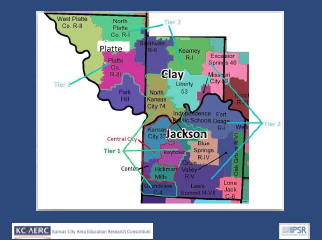Students in Transition: Resource Page
Download the SIT Foundations Presentation - 2021-04-29
Student Mobility in the Kansas City Area
In 2015, researchers with the Kansas City Area Education Research Consortium completed a significant local study on student mobility.
Their findings were presented at a community summit organized by Turn the Page KC and promoted a broader conversation on what could be done to reduce student mobility.
The study looked at students in Jackson, Clay and Platte counties. It found:
More than one in five students (36,000 students) changed schools in 2015.
Of those, more than 6,300 students changed schools two or more times.
Student transfers had a measurable impact on academic achievement based on student performance on the Missouri Standardized Assessment.
Students missed an average of four days between each transfer, with 10% of students transferring missing 12 or more days each move.
Download the study.
In the summer of 2017, Rosalie Swingle and Charis Moss researched and wrote a policy paper Creating Student Stability: Addressing Kansas City Evictions and Study Mobility as part of an Urban Leaders Fellowship through the Kansas City (MO) mayor's office.
Steve Ballmer and LINC conversation about community mobility and change
The Goodbye Kids
In Kansas City, One In Five Students Moves At Least Once During The School Year
A family needs to find a new apartment. A parent got a new job. A charter school seems to offer a better fit. Children change schools often and for many reasons during the academic year.
And yet student mobility is one of the great underreported challenges in education. Issues such as student achievement, teacher preparation, bullying and school choice command attention from school leaders and communities. Rarely does the conversation extend to classroom churn, even though it creates a state of flux that makes all the other problems more difficult to solve.
When leaders in Kansas City collected data a couple of years ago, they found that one in five students moves at least once during the school year, and those students have poorer attendance and lower achievement rates than students who do not move.
But that is only the beginning of the story. KCUR 89.3 wanted to know what all of this moving around looks like on the ground. And so we launched a project, “Musical Chairs.” Contributor Barbara Shelly spent the 2016-17 school year visiting Ingels Elementary in the Hickman Mills School District. KCUR staffer Elle Moxley added reporting from Ingels and others parts of the community. They documented the educational chaos generated as students moved continually in and out of classrooms.
We found that mobility harms all students — not just those who move around. It robs teachers of lesson time as they scramble to assess the academic levels of newcomers and introduce them to classroom routines. It leaves holes in classrooms as families often move without notice, forcing school personnel to track them down. By the second half of the year, classrooms were out of school supplies and at least one teacher was conducting an online donation drive to help her incoming students.
Kansas City Public Schools Student Mobility Study
Researchers looked at student mobility within the Kansas City Public Schools and its impact on student attainment.
Students in the KCPS system are highly mobile.
Over the past decade, at each grade level between 20-30 percent of enrolling students are new to the KCPS system.
At end of each year, 15-20 percent of the students who started that year transfer or drop out.
Of the 2,880 Kindergartners enrolled in 2008, only 360 (12.5 percent) remained in KCPS throughout our sample (ten consecutive years). Additionally, only approximately 60 percent of KCPS students are enrolled in the same school for at least 90 percent of the academic year.
More information on Kansas City area evictions at Kansas City Eviction Project.



